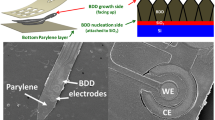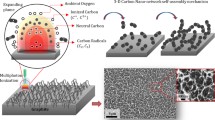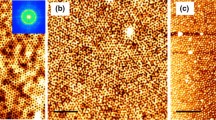Abstract
Boron-doped nanocrystalline diamond (BNCD) films exhibit outstanding electrochemical properties that make them very attractive for the fabrication of electrodes for novel neural interfaces and prosthetics. In these devices, the physicochemical properties of the electrode materials are critical to ensure an efficient long-term performance. The aim of this study was to investigate the relative contribution of topography and doping to the biological performance of BNCD films. For this purpose, undoped and boron-doped NCD films were deposited on low roughness (LR) and high roughness (HR) substrates, which were studied in vitro by means of protein adsorption and fibroblast growth assays. Our results show that BNCD films significantly reduce the adsorption of serum proteins, mostly on the LR substrates. As compared to fibroblasts cultured on LR BNCD films, cells grown on the HR BNCD films showed significantly reduced adhesion and lower growth rates. The mean length of fibronectin fibrils deposited by the cells was significantly increased in the BNCD coated substrates, mainly in the LR surfaces. Overall, the largest influence on protein adsorption, cell adhesion, proliferation, and fibronectin deposition was due to the underlying sub-micron topography, with little or no influence of boron doping. In perspective, BNCD films displaying surface roughness in the submicron range may be used as a strategy to reduce the fibroblast growth on the surface of neural electrodes.
Graphical Abstract







Similar content being viewed by others
References
Williams OA. Nanocrystalline diamond. Diam Relat Mater. 2011;20:621–40.
Amaral M, Gomes PS, Lopes MA, Santos JD, Silva RF, Fernandes MH. Nanocrystalline diamond as a coating for joint implants: cytotoxicity and biocompatibility assessment. J Nanomater. 2008;2008:1–9.
Kloss FR, Steinmüller Nethl D, Stigler RG, Ennemoser T, Rasse M, Hächl O. In vivo investigation on connective tissue healing to polished surfaces with different surface wettability. Clin Oral Implants Res. 2011;22:699–705.
Hadjinicolaou AE, Leung RT, Garrett DJ, Ganesan K, Fox K, Nayagam DAX, et al. Electrical stimulation of retinal ganglion cells with diamond and the development of an all diamond retinal prosthesis. Biomaterials. 2012;33:5812–20.
Park J, Show Y, Quaiserova V, Galligan JJ, Fink GD, Swain GM. Diamond microelectrodes for use in biological environments. J Electroanal Chem. 2005;583:56–68.
Luong JHT, Male KB, Glennon JD. Boron-doped diamond electrode: synthesis, characterization, functionalization and analytical applications. Analyst. 2009;134:1965–79.
Halpern JM, Xie S, Sutton GP, Higashikubo BT, Chestek CA, Lu H, et al. Diamond electrodes for neurodynamic studies in Aplysia californica. Diam Relat Mater. 2006;15:183–7.
Suzuki A, Ivandini TA, Yoshimi K, Fujishima A, Oyama G, Nakazato T, et al. Fabrication, characterization, and application of boron-doped diamond microelectrodes for in vivo dopamine detection. Anal Chem. 2007;79:8608–15.
Halpern JM, Cullins MJ, Chiel HJ, Martin HB. Chronic in vivo nerve electrical recordings of Aplysia californica using a boron-doped polycrystalline diamond electrode. Diam Relat Mater. 2010;19:178–81.
Chan H-Y, Aslam DM, Wiler JA, Casey B. A novel diamond microprobe for neuro-chemical and -electrical recording in neural prosthesis. J Microelectromech Syst. 2009;18:511–21.
Hébert C, Warnking J, Depaulis A, Garçon LA, Mermoux M, Eon D, et al. Microfabrication, characterization and in vivo MRI compatibility of diamond microelectrodes array for neural interfacing. Mater Sci Eng C. 2015;46:25–31.
Merrill DR. Materials considerations of implantable neuroengineering devices for clinical use. Curr Opin Solid State Mater Sci. 2014;18:329–36.
Heiduschka P, Thanos S. Implantable bioelectric interfaces for lost nerve functions. Prog Neurobiol. 1998;55:433–61.
Merrill DR, Bikson M, Jefferys JGR. Electrical stimulation of excitable tissue: design of efficacious and safe protocols. J Neurosci Methods. 2005;141:171–98.
Steinmüller-Nethl D, Kloss FR, Najam-Ul-Haq M, Rainer M, Larsson K, Linsmeier C, et al. Strong binding of bioactive BMP-2 to nanocrystalline diamond by physisorption. Biomaterials. 2006;27:4547–56.
Clem WC, Chowdhury S, Catledge SA, Weimer JJ, Shaikh FM, Hennessy KM, et al. Mesenchymal stem cell interaction with ultra-smooth nanostructured diamond for wear-resistant orthopaedic implants. Biomaterials. 2008;29:3461–8.
Kopecek M, Bacakova L, Vacik J, Fendrych F, Vorlicek V, Kratochvilova I, et al. Improved adhesion, growth and maturation of human bone-derived cells on nanocrystalline diamond films. Phys Status Solidi A. 2008;205:2146–53.
Kromka A, Grausova L, Bacakova L, Vacik J, Rezek B, Vanecek M, et al. Semiconducting to metallic-like boron doping of nanocrystalline diamond films and its effect on osteoblastic cells. Diam Relat Mater. 2010;19:190–5.
Grausova L, Kromka A, Burdikova Z, Eckhardt A, Rezek B, Vacik J, et al. Enhanced growth and osteogenic differentiation of human osteoblast-like cells on boron-doped nanocrystalline diamond thin films. PLoS One. 2011;6:e20943.
Vaitkuviene A, McDonald M, Vahidpour F, Noben J-P, Sanen K, Ameloot M, et al. Impact of differently modified nanocrystalline diamond on the growth of neuroblastoma cells. New Biotechnol. 2015;32:7–12.
Ojovan SM, McDonald M, Rabieh N, Shmuel N, Erez H, Nesladek M, et al. Nanocrystalline diamond surfaces for adhesion and growth of primary neurons, conflicting results and rational explanation. Front Neuroeng. 2014;7:17.
Yim EKF, Darling EM, Kulangara K, Guilak F, Leong KW. Nanotopography-induced changes in focal adhesions, cytoskeletal organization, and mechanical properties of human mesenchymal stem cells. Biomaterials. 2010;31:1299–306.
Pennisi CP, Dolatshahi-Pirouz A, Foss M, Chevallier J, Fink T, Zachar V, et al. Nanoscale topography reduces fibroblast growth, focal adhesion size and migration-related gene expression on platinum surfaces. Colloids Surf B. 2011;85:189–97.
Dolatshahi-Pirouz A, Kolind K, Pennisi CP, Duroux M, Zachar V, Foss M, et al. Synthesis of nano- and micro-scale topographies by combining colloidal lithography and glancing angle deposition (GLAD). Adv Eng Mater. 2015;17:8–13.
Yang L, Sheldon BW, Webster TJ. The impact of diamond nanocrystallinity on osteoblast functions. Biomaterials. 2009;30:3458–65.
Yang L, Li Y, Sheldon BW, Webster TJ. Altering surface energy of nanocrystalline diamond to control osteoblast responses. J Mater Chem. 2011;22:205.
Kalbacova M, Rezek B, Baresova V, Wolf-Brandstetter C, Kromka A. Nanoscale topography of nanocrystalline diamonds promotes differentiation of osteoblasts. Acta Biomater. 2009;5:3076–85.
Taylor A, Fendrych F, Fekete L, Vlcek J, Rezacova V, Petrak V, et al. Novel high frequency pulsed MW-linear antenna plasma-chemistry: routes towards large area, low pressure nanodiamond growth. Diam Relat Mater. 2011;20:613–5.
Pennisi CP, Zachar V, Fink T, Gurevich L, Fojan P. Patterned polymeric surfaces to study the influence of nanotopography on the growth and differentiation of mesenchymal stem cells. Methods Mol Biol. 2013;1058:77–88.
Ferrari AC, Robertson J. Origin of the 1150 cm−1 Raman mode in nanocrystalline diamond. Phys Rev B. 2001;63:121405.
Prawer S, Nemanich RJ. Raman spectroscopy of diamond and doped diamond. Philos Trans R Soc A. 2004;362:2537–65.
Taylor A, Fekete L, Hubík P, Jäger A, Janíček P, Mortet V, et al. Large area deposition of boron doped nano-crystalline diamond films at low temperatures using microwave plasma enhanced chemical vapour deposition with linear antenna delivery. Diam Relat Mater. 2014;47:27–34.
Grieten L, Janssens SD, Ethirajan A, Bon NV, Ameloot M, Michiels L, et al. Real-time study of protein adsorption on thin nanocrystalline diamond. Phys Status Solidi A. 2011;208:2093–8.
Klauser F, Hermann M, Steinmüller Nethl D, Eiter O, Pasquarelli A, Bertel E, et al. Direct and protein-mediated cell attachment on differently terminated nanocrystalline diamond. Chem Vap Deposition. 2010;16:42–9.
Comelles J, Estévez M, Martínez E, Samitier J. The role of surface energy of technical polymers in serum protein adsorption and MG-63 cells adhesion. Nanomedicine. 2010;6(1):44–51.
Shin D, Tryk DA, Fujishima A, Merkoçi A, Wang J. Resistance to surfactant and protein fouling effects at conducting diamond electrodes. Electroanalysis. 2005;17:305–11.
Dolatshahi-Pirouz A, Skeldal S, Hovgaard MB, Jensen T, Foss M, Chevallier J, et al. Influence of nanoroughness and detailed surface morphology on structural properties and water-coupling capabilities of surface-bound fibrinogen films. J Phys Chem C. 2009;113:4406–12.
Amaral M, Gomes PS, Lopes MA, Santos JD, Silva RF, Fernandes MH. Cytotoxicity evaluation of nanocrystalline diamond coatings by fibroblast cell cultures. Acta Biomater. 2009;5:755–63.
Lüthen F, Lange R, Becker P, Rychly J, Beck U, Nebe JGB. The influence of surface roughness of titanium on β1- and β3-integrin adhesion and the organization of fibronectin in human osteoblastic cells. Biomaterials. 2005;26:2423–40.
van Kooten TG, von Recum AF. Cell adhesion to textured silicone surfaces: the influence of time of adhesion and texture on focal contact and fibronectin fibril formation. Tissue Eng. 1999;5:223–40.
Mallik PK, Basu B. Better early osteogenesis of electroconductive hydroxyapatite–calcium titanate composites in a rabbit animal model. J Biomed Mater Res A. 2014;102:842–51.
Acknowledgments
This work was supported by the EU through the project MERIDIAN (Micro and Nano Engineered Bi-Directional Carbon Interfaces for Advanced Peripheral Nervous System Prosthetics and Hybrid Bionics), Contract No. 280778-02.
Funding
AFM equipment was funded by Czech Republic Ministry of Education, Youth and Sports—FUNBIO CZ.2.16/3.1.00/21568.
Author information
Authors and Affiliations
Corresponding author
Ethics declarations
Conflicts of interest
The authors have no conflicts of interest to disclose.
Rights and permissions
About this article
Cite this article
Alcaide, M., Papaioannou, S., Taylor, A. et al. Resistance to protein adsorption and adhesion of fibroblasts on nanocrystalline diamond films: the role of topography and boron doping. J Mater Sci: Mater Med 27, 90 (2016). https://doi.org/10.1007/s10856-016-5696-3
Received:
Accepted:
Published:
DOI: https://doi.org/10.1007/s10856-016-5696-3




